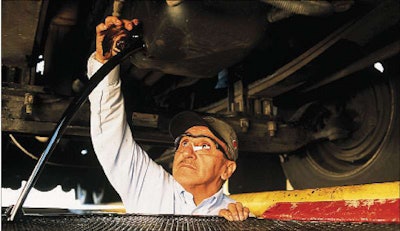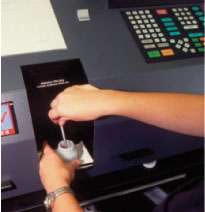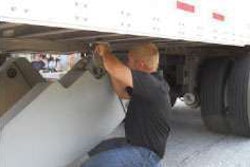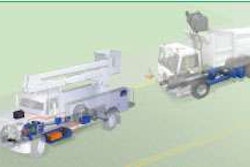Analyze This

If you think of a vehicle inspection in terms of a medical check-up, it wouldn’t be much of a stretch to look at an oil analysis as the blood test. But rather than focusing on things like cholesterol or sugar, this in-depth look at used engine oil can examine everything from the health of the engine, to the condition of the oil and unwanted contaminants in the mix.
Lilo Hurtado, application engineer at ExxonMobil, lists several questions the related reports can answer: “How is my engine oil doing? Is my oil drain interval set properly or not? Is my engine feeling sick? Are there some underlying issues that are popping up that I want to take care of today, or I want to plan to take care of soon?”
The engine wants to tell a story. The oil analysis report gives it the power to speak.
The questions are hardly limited to aging equipment, either. Owners of late-model engines often will focus on contaminants that can be traced to EGR coolant leaks or other costly issues with new aftertreatment devices.
“Anything that is coming back in the engine is ultimately going to go out the exhaust,” Hurtado says.
As important as this insight can be to a fleet, it also can play a key role in a shop’s customer loyalty program, adds James Gambill, Chevron Lubricants’ manager – direct marketing.
“Making another contact with the customer about their equipment really can help a loyalty program. It shows you really care and provides useful information to them. They still make the business decision, but you provide information so they can make a better decision,” he says.
“Being that business consultant will grow trust, and when you grow trust your business will grow.”
At their best, oil analysis programs look beyond individual readings and are used to identify trends that can appear before costly problems like a catastrophic engine failure. Increases in silicon can spot unfiltered air, and climbing levels of potassium can identify coolant leaks.
“It’s like an insurance policy,” says Dan Arcy, Shell Oil’s OEM technical manager. “You catch those things early, you save an engine.”

“The readings are really wild on many wear metals in the first three (oil) changes on a new engine, and then they come down to very low levels, and you can begin to see the trending,” Gambill explains.
“They can be five to eight times as high as what you would see on a normal basis. It’s not a little bit. It’s not 10 percent. It’s a multiple. When you look at the data on a graph it’s very telling because with the first few you see data points all over the place, and then magically after about 80,000 to 100,000 miles or the equivalent in hours, everything is kind of settled down. All the industrial products that (manufacturers are) using when they make the products are flushed out,” he says.
Arcy, for example, refers to the way potassium levels may seem unusually high in a brand new engine. On its own, that might suggest a coolant leak. But when coupled with high levels of aluminum, it could simply be coming from a brazing flux used during the production of the engine. That issue has become more common in the last five years, he notes.
Hurtado agrees: “People are knocking EGR coolers off and chasing ghosts.”
Meanwhile, engine makers who use a silicone sealant on the front gear case cover may generate higher levels of silicon during the early oil analyses. A shop that doesn’t recognize this factor may think the engine is drawing unfiltered air.
Even levels of lead can be misleading, Gambill says, referring to the material that usually can identify unwanted bearing wear. One manufacturer already is shifting away from lead, and in that case a program will need to track the levels of tin.
The focus on individual readings also can change over time.
 The quality of the data on an oil analysis report begins with properly taking an oil sample.
The quality of the data on an oil analysis report begins with properly taking an oil sample.Only a few years ago, high Total Base Numbers (TBN) were needed to combat the acids produced when diesel fuel contained higher levels of sulfur. The combination of Ultra Low Sulfur Diesel and CJ4 engine oils addressed much of that problem.
A lower TBN is less likely to cause a problem in today’s engines. It just can’t be too low. Oxides of nitrogen (NOx) still generate nitric acid, Hurtado says. Engines built to meet 2010 emissions standards are allowed to generate higher levels of NOx because it will be treated through the SCR system.
The benchmarks also can vary from one oil formula to the next. Rotella Triple Protection oil has a 10 TBN, while its predecessor had a 12 TBN, Arcy says. Differences also can be found from one brand to the next. It is difficult to identify any changes unless the lab knows the levels found in a new oil supply.
Service providers should approach their clients to discuss the ultimate goals of an oil analysis program, Arcy notes. While one fleet may be looking to extend the time between oil drain intervals, another may be trying to accurately schedule component replacements.
When it comes to extending oil drains, the Total Base Number and Total Acid Number will be important, but those shops whose customers follow a manufacturer’s drain interval recommendations may want to focus on wear metals and other contaminants.
And like any other laboratory work, an oil analysis program needs to be controlled carefully.
Says Arcy: “The quality of the data that you put in is going to help determine the quality of the information that you get out.”
In this case, the quality of the data begins with the way the oil sample is collected. At the very least, the samples should be drawn from a warm engine. “You let the truck sit all night, you may not get a representative sample of what is actually taking place,” Arcy says.
One way to solve this challenge is to take the sample itself as soon as a truck arrives at the shop, or drive around the parking lot a few times before taking the test.
Technicians who simply draw the oil flowing from a drain plug will want to make sure they collect the content halfway into the available stream.
But even that can lead to problems, since the midway point can be a matter of opinion. Just how much oil has drained already? How much remains?
“That (the oil pan) is the worst place to pull it from,” Hurtado insists. “The oil pan is the garbage pan of the engine, and it’s supposed to hold all of the particulate, all of the soot, and it is the resting place for the oil to kind of rejuvenate itself to control the aging process of the oil. You’re taking a biased sample by taking it from the bottom of the oil pan.”
 Oil analysis can give information on the health of the engine, the condition of the oil and the presence of unwanted contaminants.
Oil analysis can give information on the health of the engine, the condition of the oil and the presence of unwanted contaminants.The best option is to install an oil sampling valve on any engine participating in an analysis program, he says. Some of the valves can cost as little as $15 to $60, depending on the plumbing involved, and are installed in a threaded port on the oil galley.
Granted, some added plumbing may be needed if the valve has to be moved, to protect technicians from touching a hot turbocharger.
Failing that, technicians can equip themselves with an oil sieve vacuum pump for under $30, but there will be important steps to follow. The tool’s plastic hose should be fed a specific distance down through the dipstick tube, every time a sample is drawn. This distance can be measured against the dipstick itself.
Simple record-keeping procedures also can make a difference.
Most oil samples arrive at a lab with information to identify a customer, but lack details about the type of oil, accumulated miles or the model of engine, Gambill says.
The missing facts are needed to identify any real trends. After all, the simple shift from one oil to another can set different benchmarks for everything from viscosity to the TBN, and that makes a difference in warning limits. A soot level of 5 percent may be a cause for alarm at 15,000 miles, but be acceptable at 30,000 miles.
Shops also need to be aware that labs can report results in different ways. Some reports identify soot levels by volume rather than weight, and that could leave people with a false sense of security, Hurtado says. Most manufacturers base their limits on weight.
Any collected samples also need to be delivered to the lab as soon as possible. “The faster you can get it sent in, if there is an issue, you can catch it faster and deal with the problem,” Arcy says.
Unfortunately, many shops will collect samples for several days before shipping the material to the lab.
The choice of a lab will make a difference of its own, Gambill says, noting how that will affect everything from the speed of test results to support in tracking the related reports.
Results should take no more than three days in most markets, and they can come as quickly as one day in a major market. “Ask them for examples of what they’ve done for other customers,” he adds.
A lab’s quality control measures are equally important. Hurtado stresses the need to ask how often equipment is calibrated, and whether the lab participates in ASTM round-robin tests, which test their readings against calibrated oil samples.
“Some labs’ internal standards are even more stringent than industry-based standards,” he says.
Accurate reports always tell the most detailed stories.










